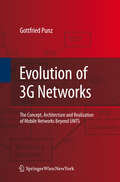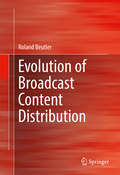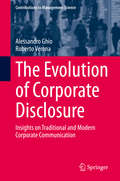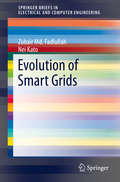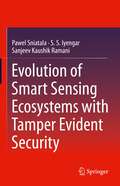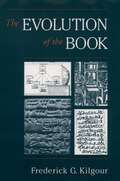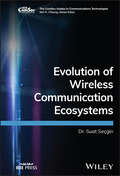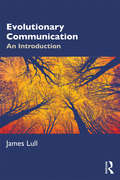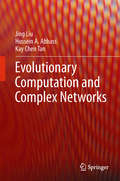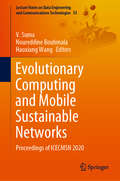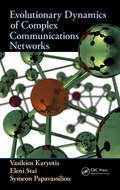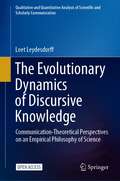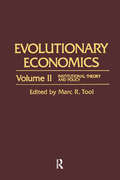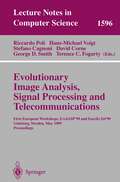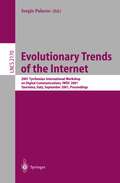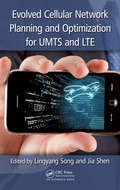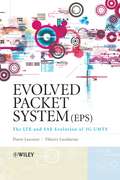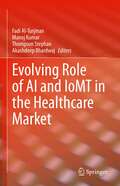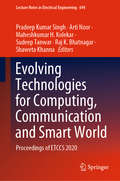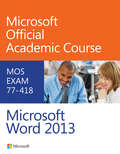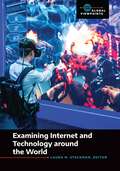- Table View
- List View
Evolution of 3G Networks: The Concept, Architecture and Realization of Mobile Networks Beyond UMTS
by Gottfried PunzIn this chapter we describe the motivation for writing this book and explain its scope. Some remarks on nomenclature are given in order to help the reader with a fast and easy start. The concept and structure of the material compiled is p- sented, followed by some hints on how to make best use of it. Finally the status of standardization, on which this book is based, is described. 1. 1 Motivation Probably the main motivation for starting to draft the script for this book, and eventually to finish it, was the desire to have a more or less complete, up-to-date overview of mobile network technology for myself, not only when starting my work in 3GPP standardization, but also continuously afterwards. I realized that some of my colleagues were in search of the same, and I extrapolated to the point where, after 3G technology is in in the field for some time, the huge, new step of development would be implemented and finally exist in reality: a manifold of s- tem designers, SW engineers, solution consultants, test personnel, field tech- cians and service staff would have to deal with the underlying architecture, c- cepts and detailed procedures. Yet, I noticed in my roughly two decades of work as a engineer (in a few diverse fields) that compact, consistent, and balanced ov- view material, suitable for the wider audience is scarce.
Evolution of Broadcast Content Distribution
by Roland BeutlerThis book discusses opportunities for broadcasters that arise with the advent of broadband networks, both fixed and mobile. It discusses how the traditional way of distributing audio-visual content over broadcasting networks has been complemented by the usage of broadband networks. The author shows how this also gives the possibility to offer new types of interactive or so-called nonlinear services. The book illustrates how change in distribution technology is accelerating the need for broadcasters around the world to adapt their content distribution strategy and how it will impact the portfolios of content they offer.
The Evolution of Corporate Disclosure: Insights on Traditional and Modern Corporate Communication (Contributions to Management Science)
by Alessandro Ghio Roberto VeronaThis book provides a critical analysis of the evolution of corporate disclosure. Building upon prior academic literature, it assesses the most important changes in mandatory corporate disclosure, the growing relevance of social and environmental disclosure, and revolutionary new forms of corporate communication, in particular social media. It also includes empirical analyses that shed further light on the impact of voluntary communication, i.e. social and environmental reporting and corporate social media communication, on managerial and investment decisions. Lastly, it discusses new directions for accounting and corporate governance research on the theoretical and empirical challenges of corporate disclosure. Offering a wealth of relevant and timely advice, the book will help regulators design policies that allow businesses to overcome current and emerging economic, social, and technological challenges.
Evolution of Smart Grids (SpringerBriefs in Electrical and Computer Engineering #0)
by Zubair Md. Fadlullah Nei KatoThis SpringerBrief explores the opportunities and challenges posed by the smart grid. The evolution of the smart grid should allow consumers to directly communicate with their utility provider. However, complex issues such as architecture with legacy support, varying demand response and load management, varying price of power, and so forth can lead to various decision making challenges. It is essential to identify the scope and challenges of the smart grid in a comprehensive manner so as to ensure efficient delivery of sustainable, economic, and secure electricity supplies. This book provides an overview of the smart grid and its key advances in architecture, distribution management, demand-side response and load balancing, smart automation, electric storage, power loss minimization and security. Readers interested in a basic knowledge of electric grid and communication networks will find Evolution of Smart Grids useful. Readers who want more insight on smart grid research will also find this book a valuable resource.
Evolution of Smart Sensing Ecosystems with Tamper Evident Security
by Pawel Sniatala S.S. Iyengar Sanjeev Kaushik RamaniThis book presents an overview on security and privacy issues in dynamic sensor networks and Internet of Things (IoT) networks and provides a novel tamper evident technique to counter and defend against these security related issues. The mission of this book is to explain the evolution of techniques and strategies in securing information transfer and storage thus facilitating a digital transition towards the modern tamper evident systems. The goal is also to aid business organizations that are dependent on the analysis of the large volumes of generated data in securing and addressing the associated growing threat of attackers relentlessly waging attacks and the challenges in protecting the confidentiality, integrity and provenance of data. The book also provides a comprehensive insight into the secure communication techniques and tools that have evolved and the impact they have had in supporting and flourishing the business through the cyber era. This book also includes chapters that discuss the most primitive encryption schemes to the most recent use of homomorphism in ensuring the privacy of the data thus leveraging greater use of new technologies like cloud computing and others.
The Evolution of the Book
by Frederick G. KilgourDistinguished scholar and library systems innovator Frederick Kilgour tells a five-thousand-year story in this exciting work, a tale beginning with the invention of writing and concluding with the emerging electronic book. Calling on a lifetime of interest in the growth of information technology, Kilgour brings a fresh approach to the history of the book, emphasizing in rich, authoritative detail the successive technological advances that allowed the book to keep pace with ever-increasing needs for information. Borrowing a concept from evolutionary theory--the notion of punctuated equilibria--to structure his account, Kilgour investigates the book's three discrete historical forms--the clay tablet, papyrus roll, and codex--before turning to a fourth, still evolving form, the cyber book, a version promising swift electronic delivery of information in text, sound, and motion to anyone at any time. The clay tablet, initially employed as a content descriptor for sacks of grain, proved inadequate to the growing need for commercial and administrative records. Its successor the papyrus roll was itself succeeded by the codex, a format whose superior utility and information capacity led to sweeping changes in the management of accumulated knowledge, the pursuit of learning, and the promulgation of religion. Kilgour throughout considers closely both technological change and the role this change played in cultural transformation. His fascinating account of the modern book, from Gutenberg's invention of cast-type printing five hundred years ago to the arrival of books displayed on a computer screen, spotlights the inventors, engineers, and entrepreneurs who in creating the machinery of production and dissemination enabled the book to maintain its unique cultural power over time. Deft, provocative, and accessibly written, The Evolution of the Book will captivate book lovers as well as those interested in bibliographic history, the history of writing, and the history of technology.
The Evolution of the Book
by Frederick G. KilgourDistinguished scholar and library systems innovator Frederick Kilgour tells a five-thousand-year story in this exciting work, a tale beginning with the invention of writing and concluding with the emerging electronic book. Calling on a lifetime of interest in the growth of information technology, Kilgour brings a fresh approach to the history of the book, emphasizing in rich, authoritative detail the successive technological advances that allowed the book to keep pace with ever-increasing needs for information. Borrowing a concept from evolutionary theory--the notion of punctuated equilibria--to structure his account, Kilgour investigates the book's three discrete historical forms--the clay tablet, papyrus roll, and codex--before turning to a fourth, still evolving form, the cyber book, a version promising swift electronic delivery of information in text, sound, and motion to anyone at any time. The clay tablet, initially employed as a content descriptor for sacks of grain, proved inadequate to the growing need for commercial and administrative records. Its successor the papyrus roll was itself succeeded by the codex, a format whose superior utility and information capacity led to sweeping changes in the management of accumulated knowledge, the pursuit of learning, and the promulgation of religion. Kilgour throughout considers closely both technological change and the role this change played in cultural transformation. His fascinating account of the modern book, from Gutenberg's invention of cast-type printing five hundred years ago to the arrival of books displayed on a computer screen, spotlights the inventors, engineers, and entrepreneurs who in creating the machinery of production and dissemination enabled the book to maintain its unique cultural power over time. Deft, provocative, and accessibly written, The Evolution of the Book will captivate book lovers as well as those interested in bibliographic history, the history of writing, and the history of technology.
Evolution of Wireless Communication Ecosystems (The ComSoc Guides to Communications Technologies)
by Suat SecginEvolution of Wireless Communication Ecosystems Understand a world transformed by wireless communication with this groundbreaking guide Since the advent of the internet, few technologies have proven more transformative than wireless communication. Never have we lived in a more comprehensively connected world, with the cloud and the coming sixth generation (6G) of wireless technology creating a vast and interconnected communications infrastructure. Global citizens of this newly interconnected reality are grappling like never before with its many challenges. Evolution of Wireless Communication Ecosystems provides readers with a history of wireless communication and a thorough overview of emerging frontiers. It traces wireless communication from the first generation through to the current fifth before surveying the current state of wireless technology and the ongoing research into 6G. The result is a book that understands wireless communication for the first time as an ecosystem, endlessly interconnected, growing, and boundlessly complex, but made intelligible by this highly readable introduction. Readers will also find: Detailed explanations of the journey starting from 1G to 6G Descriptions the infrastructure of 4G, 5G, and 6G systems, this all-connected communication ecosystem, the sub-components of this ecosystem, and the relationship among them Depictions of events seen in the capillaries of the communication echo system that show switching techniques, modulation, and multiplexing techniques Coverage of access techniques, protocols, the methods used in M2M and IoT connections at the endpoints, and security issues that show how they are an integral part of wireless communication infrastructure Evolution of Wireless Communication Ecosystems from 1G to 6G is an essential reference for wireless and telecommunications professionals, as well as researchers interested in 6G or other emerging wireless technologies.
Evolution of Wireless Communication Ecosystems (The ComSoc Guides to Communications Technologies)
by Suat SecginEvolution of Wireless Communication Ecosystems Understand a world transformed by wireless communication with this groundbreaking guide Since the advent of the internet, few technologies have proven more transformative than wireless communication. Never have we lived in a more comprehensively connected world, with the cloud and the coming sixth generation (6G) of wireless technology creating a vast and interconnected communications infrastructure. Global citizens of this newly interconnected reality are grappling like never before with its many challenges. Evolution of Wireless Communication Ecosystems provides readers with a history of wireless communication and a thorough overview of emerging frontiers. It traces wireless communication from the first generation through to the current fifth before surveying the current state of wireless technology and the ongoing research into 6G. The result is a book that understands wireless communication for the first time as an ecosystem, endlessly interconnected, growing, and boundlessly complex, but made intelligible by this highly readable introduction. Readers will also find: Detailed explanations of the journey starting from 1G to 6G Descriptions the infrastructure of 4G, 5G, and 6G systems, this all-connected communication ecosystem, the sub-components of this ecosystem, and the relationship among them Depictions of events seen in the capillaries of the communication echo system that show switching techniques, modulation, and multiplexing techniques Coverage of access techniques, protocols, the methods used in M2M and IoT connections at the endpoints, and security issues that show how they are an integral part of wireless communication infrastructure Evolution of Wireless Communication Ecosystems from 1G to 6G is an essential reference for wireless and telecommunications professionals, as well as researchers interested in 6G or other emerging wireless technologies.
Evolutionary Communication: An Introduction
by James LullEvolutionary Communication presents the first comprehensive evolutionary approach to the study of human communication. Presuming no specialized knowledge of evolutionary theory, this reader-friendly textbook explains why and how communication became the determining factor in human development. Drawing from the latest scientific research, Evolutionary Communication represents a truly groundbreaking contribution to Communication Studies as a field of study. Opening up an inspiring new approach for teaching communication, the book can be used as a core volume or supplemental text for courses ranging from Introduction to Communication and Communication Theory to special topics and graduate seminars.
Evolutionary Communication: An Introduction
by James LullEvolutionary Communication presents the first comprehensive evolutionary approach to the study of human communication. Presuming no specialized knowledge of evolutionary theory, this reader-friendly textbook explains why and how communication became the determining factor in human development. Drawing from the latest scientific research, Evolutionary Communication represents a truly groundbreaking contribution to Communication Studies as a field of study. Opening up an inspiring new approach for teaching communication, the book can be used as a core volume or supplemental text for courses ranging from Introduction to Communication and Communication Theory to special topics and graduate seminars.
Evolutionary Computation and Complex Networks
by Jing Liu Hussein A. Abbass Kay Chen TanThis book introduces the linkage between evolutionary computation and complex networks and the advantages of cross-fertilising ideas from both fields. Instead of introducing each field individually, the authors focus on the research that sits at the interface of both fields. The book is structured to address two questions: (1) how complex networks are used to analyze and improve the performance of evolutionary computation methods? (2) how evolutionary computation methods are used to solve problems in complex networks? The authors interweave complex networks and evolutionary computing, using evolutionary computation to discover community structure, while also using network analysis techniques to analyze the performance of evolutionary algorithms. The book is suitable for both beginners and senior researchers in the fields of evolutionary computation and complex networks.
Evolutionary Computing and Mobile Sustainable Networks: Proceedings of ICECMSN 2020 (Lecture Notes on Data Engineering and Communications Technologies #53)
by V. Suma Noureddine Bouhmala Haoxiang WangThis book features selected research papers presented at the International Conference on Evolutionary Computing and Mobile Sustainable Networks (ICECMSN 2020), held at the Sir M. Visvesvaraya Institute of Technology on 20–21 February 2020. Discussing advances in evolutionary computing technologies, including swarm intelligence algorithms and other evolutionary algorithm paradigms which are emerging as widely accepted descriptors for mobile sustainable networks virtualization, optimization and automation, this book is a valuable resource for researchers in the field of evolutionary computing and mobile sustainable networks.
Evolutionary Dynamics of Complex Communications Networks
by Vasileios Karyotis Eleni Stai Symeon PapavassiliouUntil recently, most network design techniques employed a bottom-up approach with lower protocol layer mechanisms affecting the development of higher ones. This approach, however, has not yielded fascinating results in the case of wireless distributed networks. Addressing the emerging aspects of modern network analysis and design, Evolutionary Dyna
The Evolutionary Dynamics of Discursive Knowledge: Communication-Theoretical Perspectives on an Empirical Philosophy of Science (Qualitative and Quantitative Analysis of Scientific and Scholarly Communication)
by Loet LeydesdorffThis open access book addresses three themes which have been central to Leydesdorff's research: (1) the dynamics of science, technology, and innovation; (2) the scientometric operationalization of these concept; and (3) the elaboration in terms of a Triple Helix of university-industry-government relations. In this study, I discuss the relations among these themes. Using Luhmann's social-systems theory for modelling meaning processing and Shannon's theory for information processing, I show that synergy can add new options to an innovation system as redundancy. The capacity to develop new options is more important for innovation than past performance. Entertaining a model of possible future states makes a knowledge-based system increasingly anticipatory. The trade-off between the incursion of future states on the historical developments can be measured using the Triple-Helix synergy indicator. This is shown, for example, for the Italian national and regional systems of innovation.
Evolutionary Economics
by Marc R. ToolThis two-volume work is intended to map the theoretical heartland of the institutionalist perspective on political economy. Volume I, "Foundations of Institutional Thought", identifies the origins of institutional economics and explores the primary analytical tools in its development. The papers included in Volume II, "Institutional Theory and Policy", consider basic economic processes, institutions for stabilizing and planning economic activities, the role of power and accountability, and emerging global interdependence. Marc R. Tool is the editor of "Journal of Economic Issues".
Evolutionary Economics: Institutional Theory And Policy
by Marc R. ToolThis two-volume work is intended to map the theoretical heartland of the institutionalist perspective on political economy. Volume I, "Foundations of Institutional Thought", identifies the origins of institutional economics and explores the primary analytical tools in its development. The papers included in Volume II, "Institutional Theory and Policy", consider basic economic processes, institutions for stabilizing and planning economic activities, the role of power and accountability, and emerging global interdependence. Marc R. Tool is the editor of "Journal of Economic Issues".
Evolutionary Image Analysis, Signal Processing and Telecommunications: First European Workshops, EvoIASP'99 and EuroEcTel'99 Göteborg, Sweden, May 26-27, 1999, Proceedings (Lecture Notes in Computer Science #1596)
by Riccardo Poli Hans-Michael Voigt Stefano Cagnoni David Corne George D. Smith Terence C. FogartyThis book consitutes the refereed joint proceedings of the First European Workshop on Evolutionary Computation in Image Analysis and Signal Processing, EvoIASP '99 and of the First European Workshop on Evolutionary Telecommunications, EuroEcTel '99, held in Göteborg, Sweden in May 1999. The 18 revised full papers presented were carefully reviewed and selected for inclusion in the volume. The book presents state-of-the-art research results applying techniques from evolutionary computing in the specific application areas.
Evolutionary Trends of the Internet: 2001 Thyrrhenian International Workshop on Digital Communications, IWDC 2001, Taormina, Italy, September 17-20, 2001. Proceedings (Lecture Notes in Computer Science #2170)
by Sergio PalazzoThis book constitutes the refereed proceedings of the Thyrrhenian International Workshop on Digital Communication, IWDC 2001, held in Taormina, Italy in September 2001.The 46 revised full papers presented are a mix of invited papers and selected submitted papers and reflect the state of the art in multiservice IP network research and development. The book offers topical sections on WDM technologies for the next generation Internet, mobile and wireless Internet access, QoS in the next generation Internet, multicast and routing in IP networks, mulitmedia services over the Internet, performance of Internet protocols, dynamic service management, and source encoding and Internet applications.
Evolved Cellular Network Planning and Optimization for UMTS and LTE
by Lingyang Song Jia ShenMost books on network planning and optimization provide limited coverage of either GSM or WCDMA techniques. Few scrape the surface of HSPA, and even fewer deal with TD-SCDMA. Filling this void, Evolved Cellular Network Planning and Optimization for UMTS and LTE presents an accessible introduction to all stages of planning and optimizing UMTS, HSPA,
Evolved Packet System (EPS): The LTE and SAE Evolution of 3G UMTS
by Pierre Lescuyer Thierry Lucidarme2G/GSM and 3G/UMTS are key mobile communication technologies, chosen by more than 2 billion people around the world. In order to adapt to new services, increasing demand for user bandwidth, quality of service and requirements for network convergence, major evolutions are introduced in 3G network standard. Evolved Packet System (EPS) presents the EPS evolution of the 3G/UMTS standard introduced by the 3rd Generation Partnership Project (3GPP) standard committee. This new topic is looked at from a system perspective, from the radio interface to network and service architecture. Hundreds of documents being issued by Standard organisations are summarised in one book to allow the reader to get an accessible comprehensive view of EPS evolution. Proposes a system view of Evolved UMTS, from the radio to Core and service architecture Gives a comprehensive and global view of the system that technical specifications do not provide Describes the new system as well as the inheritance and migration from 2G/GSM and 3G/UMTS Written by experts in the field who specialise in two complementary but very different technical domains (i.e. "radio interface" and "network architecture") Contains many figures and examples for better understanding. This book is essential for industry professionals in the telecommunication business, telecommunication system architects and designers, product manufacturers and operators and postgraduate students.
Evolving Role of AI and IoMT in the Healthcare Market
by Manoj Kumar Fadi Al-Turjman Akashdeep Bhardwaj Thompson StephanThis book is a proficient guide to understanding artificial intelligence (IoT) and the Internet of Medical Things (IoMT) in healthcare. The book provides a comprehensive study on the applications of AI and IoT in various medical domains. The book shows how the implementation of innovative solutions in healthcare is beneficial, and IoT, together with AI, are strong drivers of the digital transformation regardless of what field the technologies are applied in. Therefore, this book provides a high level of understanding with the emerging technologies on the Internet of Things, wearable devices, and AI in IoMT, which offers the potential to acquire and process a tremendous amount of data from the physical world.
Evolving Technologies for Computing, Communication and Smart World: Proceedings of ETCCS 2020 (Lecture Notes in Electrical Engineering #694)
by Pradeep Kumar Singh Arti Noor Maheshkumar H. Kolekar Sudeep Tanwar Raj K. Bhatnagar Shaweta KhannaThis book presents best selected papers presented at the International Conference on Evolving Technologies for Computing, Communication and Smart World (ETCCS 2020) held on 31 January–1 February 2020 at C-DAC, Noida, India. It is co-organized by Southern Federal University, Russia; University of Jan Wyżykowski (UJW), Polkowice, Poland; and CSI, India. C-DAC, Noida received funding from MietY during the event. The technical services are supported through EasyChair, Turnitin, MailChimp and IAC Education. The book includes current research works in the areas of network and computing technologies, wireless networks and Internet of things (IoT), futuristic computing technologies, communication technologies, security and privacy.
Exam 77-418 Microsoft Word 2013 (Microsoft Official Academic Course Series)
by Microsoft Official Academic CourseThis Microsoft Word 2013, Exam 77-418 is the only Microsoft Official Academic Course (MOAC) textbook. This series includes a complete classroom instructional program. This Word 2013 text is mapped to the Word 2013 certification exam objectives and is designed to re-enforce workforce skills. With this book students learn to create and edit professional-looking documents for a variety of purposes and situations. It also covers such skills as browsing, sorting and finding information, accessing and sharing documents from anywhere, enhancing visual impact with picture editing tools, text effects, SmartArt Graphics, and much more. The Microsoft Official Academic Course (MOAC) Office series also offers OfficeGrader. This valuable tool corrects your students tasked-based assignments. Students work on real-world problems like the ones they will encounter in the workforce ensuring they are ready for real professional challenges. OfficeGrader allows for efficient and consistent grading saving time for other important teaching activities. Grading is easier than ever allowing faster assignment turnaround to students. Word 2013 certification can help students with classwork and differentiate job hunters in todays competitive job market. Students who have earned certification can broaden their employment opportunities in such fields as clerical, office professionals, consultants, executives/managers, help desk personnel, instructors/trainers, marketing personnel, product developers, sales, and writers.
Examining Internet and Technology around the World (Global Viewpoints)
by Laura M. SteckmanThis book offers comparative insights into the challenges and opportunities surrounding emerging technology and the internet as it is used and perceived throughout the world, providing students with cross-cultural and cross-national perspectives.The United Arab Emirates has a national goal of colonizing Mars by 2117, and China seeks to modernize its entire manufacturing process to produce cutting-edge technologies and research advances by 2025. How are other countries using the internet and emerging technologies to their advantage? This volume in the Global Viewpoints series examines 10 issues pertaining to the internet and technology, including access and censorship, alternative energy technologies, artificial intelligence, autonomous robots, cyberbullying, cybercrime, e-learning, GMOs, online privacy, and virtual and augmented reality. For each topic, the volume features eight country-level perspectives that span the world to allow for comparisons of different nations' specific approaches to the technology or issue. This encyclopedia takes a new direction in understanding the importance and impact of emerging technologies on the world, showing that even when experiencing similar technologically related challenges or advances, these technologies do not form one-size-fits-all solutions for every nation and population. Even when nations develop similar technologies, human dimensions—from policy to social norms to culture—influence people and society across the world differently.
